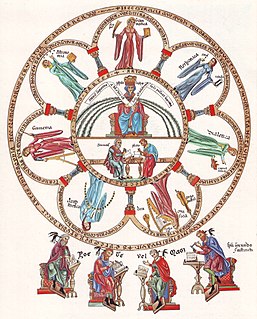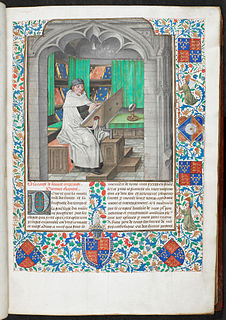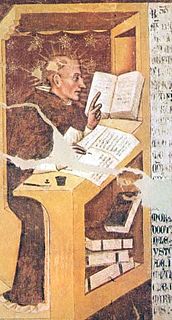 W
WAbrogans, also German Abrogans or Codex Abrogans, is a Middle Latin–Old High German glossary, whose preserved copy in the Abbey Library of St Gall is regarded as the oldest preserved book in the German language.
 W
WBald's Leechbook is an Old English medical text probably compiled in the ninth century, possibly under the influence of Alfred the Great's educational reforms.
 W
WEtymologiae, also known as the Origines ("Origins") and usually abbreviated Orig., is an etymological encyclopedia compiled by Isidore of Seville (c. 560–636) towards the end of his life. Isidore was encouraged to write the book by his friend Braulio, Bishop of Saragossa. The Etymologies summarized and organized a wealth of knowledge from hundreds of classical sources; three of its books are derived largely from Pliny the Elder's Natural History. Isidore acknowledges Pliny, but not his other principal sources, namely Cassiodorus, Servius and Solinus. The work contains whatever Isidore, an influential Christian bishop, thought worth keeping. Its subject matter is extremely diverse, ranging from grammar and rhetoric to the earth and the cosmos, buildings, metals, war, ships, humans, animals, medicine, law, religions and the hierarchies of angels and saints.
 W
WFons memorabilium universi is an early encyclopedia, written in Latin by the Italian humanist Domenico Bandini of Arezzo . Planned to inform and edify educated men who lack other books, the work covered God and the natural world, as was common for encyclopedias of the time, but also added a voluminous last part dealing with man and historical figures, philosophy and history, theology, ethics, heretics and women.
 W
WHortus deliciarum is a medieval manuscript compiled by Herrad of Landsberg at the Hohenburg Abbey in Alsace, better known today as Mont Sainte-Odile. It was an illuminated encyclopedia, begun in 1167 as a pedagogical tool for young novices at the convent. It is the first encyclopedia that was evidently written by a woman. It was finished in 1185, and was one of the most celebrated illuminated manuscripts of the period. The majority of the work is in Latin, with glosses in German.
 W
WLiber Floridus is a medieval encyclopedia that was compiled between 1090 and 1120 by Lambert, Canon of Saint-Omer. The text compiles extracts from some 192 or so different works.
 W
WThe Llibre de les Dones is a book that was possibly written between 1387 and 1392 by Francesc Eiximenis in Catalan in Valencia and dedicated to Sanxa Ximenes d'Arenós, countess of Prades.
 W
WLo Crestià was an encyclopaedia written in Catalan, that was sponsored by the king Peter IV of Aragon and written by Francesc Eiximenis between 1379 and 1392. The first book and the half of the twelfth one were printed by the German printer Lambert Palmart in Valencia in 1483 and 1484.
 W
WOmne Bonum is a 14th-century encyclopedia compiled in London. It survives in four volumes in the manuscripts BL Royal 6 E VI and VII, written by James le Palmer, identified on the basis of a colophon in the same hand in Bodleian Library Laud Misc. 165, clerk of the Exchequer mentioned between 1357 and 1375. The MSS. had the inventory number 1226 in the English Royal Library. It was acquired by the Upper Library at Westminster between 1542 and 1666 and was presented to the British Museum in 1757.
 W
WOtia Imperialia is an early 13th-century encyclopedic work, the best known work of Gervase of Tilbury. It is an example of Speculum literature. Also known as the "Book of Marvels", it primarily concerns the three fields of history, geography, and physics, but its credibility has been questioned by numerous scholars including philosopher Gottfried Leibniz, who was alerted to the fact that it contains many mythological stories. Its manner of writing is perhaps because the work was written to provide entertainment to Holy Roman Emperor Otto IV. However, many scholars consider it a very important work in that it "recognizes the correctness of the papal claims in the conflict between Church and Empire." It was written between 1210 and 1214, although some give the dates as between 1209 and 1214 and numerous authors state it was published c.1211.
 W
WThe medieval genre of speculum literature, popular from the twelfth through the sixteenth centuries, was inspired by the urge to encompass encyclopedic knowledge within a single work. However, some of these works have a restricted scope and function as instructional manuals. In this sense encyclopedias and speculum are similar but they are not the same genre. Some have suggested that the modern equivalent is a summary survey, in the sense of a survey article in a scholarly journal that summarizes a field of research.
 W
WTree of Science is one of the most extensive and characteristic works of Ramon Llull, written in Rome between 1295 and 1296. It is a version in encyclopaedia format of General Art or Ars magna aimed to non-university public. It has recourse to an analogy common in it: the organic comparison, in which each science is represented by a tree with roots, trunk, branches, leaves and fruits. The roots represent the basic principles of each science; the trunk is the structure; the branches, the genres; the leaves, the species; and the fruits, the individual, his/her acts and his/her finalities. This vegetal allegory shows the influence of Aristotle.
 W
WVincent of Beauvais was a Dominican friar at the Cistercian monastery of Royaumont Abbey, France. He is known mostly for his Great Mirror, a major work of compilation that was widely read in the Middle Ages. Often retroactively described as an encyclopedia or as a florilegium, his text exists as a core example of brief compendiums produced in medieval Europe.